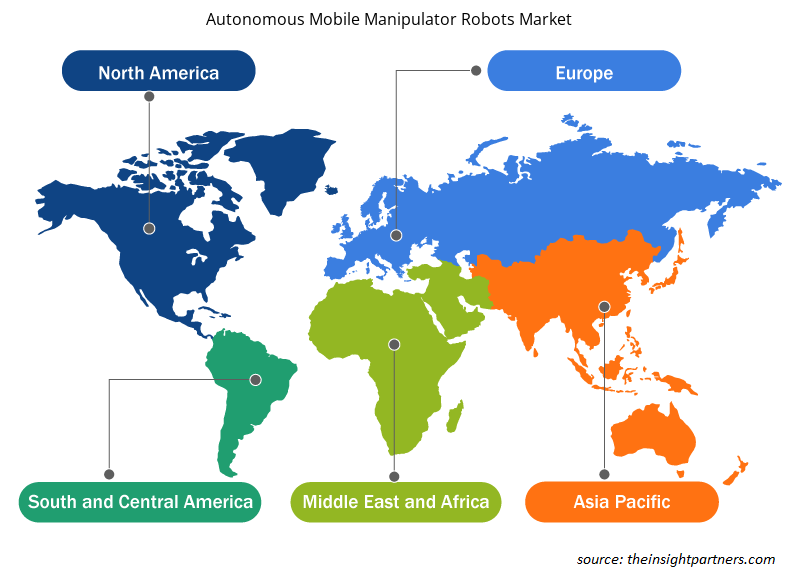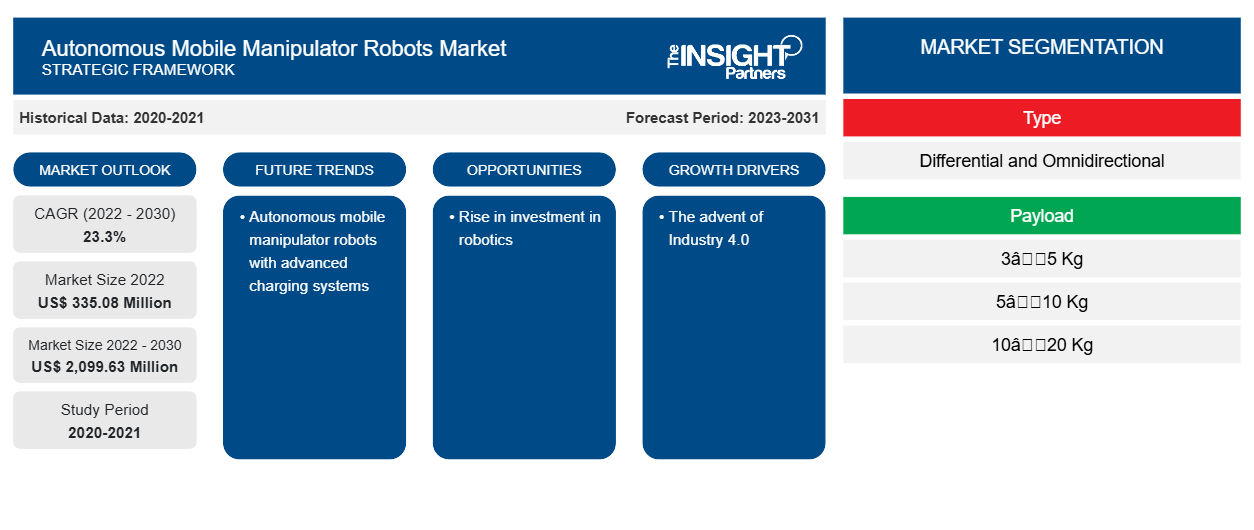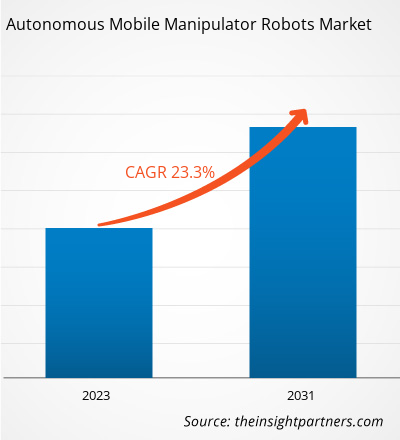Si prevede che la dimensione del mercato dei robot manipolatori mobili autonomi raggiungerà i 2.099,63 milioni di dollari entro il 2030, rispetto ai 335,08 milioni di dollari del 2022. Si prevede che il mercato registrerà un CAGR del 23,3% nel periodo 2022-2030. L'aumento della domanda di sistemi automatizzati e la crescita del settore dell'e-commerce rimarranno probabilmente tendenze chiave nel mercato.
Analisi di mercato dei robot manipolatori mobili autonomi
La crescita del settore dell'e-commerce e l'avvento dell'Industria 4.0 sono alcuni dei principali fattori trainanti del mercato dei robot manipolatori mobili autonomi. L'aumento dell'automazione di fabbrica in tutto il mondo sta alimentando la crescita del mercato. La capacità di questi robot di gestire oggetti di diverse dimensioni, forme e pesi contribuisce alla loro crescente domanda in diversi settori di utenti finali come produzione, automotive, logistica, magazzinaggio e altri.
Panoramica del mercato dei robot manipolatori mobili autonomi
I robot manipolatori mobili autonomi (AMMR) sono un tipo di robot manipolatore mobile autonomo (AMR) con un braccio robotico o manipolatore montato. Questi robot integrano le capacità di manipolazione di un braccio robotico con la mobilità di una piattaforma mobile. Può funzionare quando è in movimento e nel frattempo esegue attività di movimentazione di parti come il trasporto, il posizionamento di oggetti o il sollevamento. I robot manipolatori mobili autonomi hanno ampie applicazioni nel settore della logistica e dei magazzini per trasportare merci tra scaffali o aree di stoccaggio. L'industria manifatturiera lo utilizza per spostare materiali o manipolare parti tra diverse postazioni di lavoro in modo autonomo.
Personalizza questo report in base alle tue esigenze
Riceverai la personalizzazione gratuita di qualsiasi report, comprese parti di questo report, o analisi a livello nazionale, pacchetto dati Excel, oltre a usufruire di grandi offerte e sconti per start-up e università
- Scopri le principali tendenze di mercato in questo rapporto.Questo campione GRATUITO includerà analisi di dati che spaziano dalle tendenze di mercato alle stime e alle previsioni.
Robot manipolatori mobili autonomi: driver di mercato e opportunità
L'avvento dell'Industria 4.0 per favorire il mercato
L'avvento dell'Industria 4.0 in vari settori, come l'automotive, la produzione e altri, sta guidando l'adozione di robot per svolgere le loro attività manuali ripetitive. L'adozione di soluzioni di robotica fornisce un vantaggio competitivo all'azienda e aiuta a massimizzare la loro produzione. Aiuta a migliorare la qualità del prodotto e a ridurre al minimo l'errore umano. Pertanto, la necessità di automatizzare le loro strutture, gli attori del settore stanno ampiamente adottando robot manipolatori mobili autonomi per eseguire attività come smistamento, prelievo, spostamento e altri.
Aumento degli investimenti nella robotica.
In tutto il mondo, la tecnologia robotica sta guadagnando popolarità grazie alla sua capacità di automatizzare attività ripetitive e ridurre al minimo l'errore umano. L'automazione dei processi aiuta le aziende ad alimentare la loro capacità e capacità produttiva. Pertanto, per soddisfare questa esigenza, vari attori del mercato stanno investendo in tecnologie avanzate. Ad esempio, nell'aprile 2024, Collaborative Robotics ha chiuso un round di serie B da 100 milioni di dollari sulla strada per la commercializzazione del suo manipolatore mobile autonomo. L'azienda con sede a Santa Clara, California, ha affermato di stare sviluppando robot in grado di lavorare in modo sicuro e conveniente insieme alle persone in vari flussi di lavoro di produzione, supply chain e assistenza sanitaria. In molti casi, questo è lo stesso lavoro per cui si stanno battendo i robot umanoidi.
Analisi della segmentazione del rapporto di mercato dei robot manipolatori mobili autonomi
I segmenti chiave che hanno contribuito alla derivazione dell'analisi di mercato dei robot manipolatori mobili autonomi sono tipologia, carico utile, applicazione, settore di utilizzo finale.
- In base al tipo, il mercato dei robot manipolatori mobili autonomi è diviso in differenziale e omnidirezionale. Si prevede che il segmento omnidirezionale crescerà con il CAGR più elevato.omnidirectional. The omnidirectional segment is expected to grow with the highest CAGR.
- In base al carico utile, il mercato è segmentato in 3–5 Kg, 5–10 Kg, 10–20 Kg e 20 Kg e oltre. Si prevede che i 20 Kg e oltre cresceranno con il CAGR più elevato.CAGR.
- Per applicazione, il mercato è segmentato in smistamento, pick & place, gestione dell'inventario e altri. La gestione dell'inventario ha detenuto una quota significativa del mercato nel 2022.
- In base al settore di utilizzo finale, il mercato è segmentato in sanità , spazio, assemblaggio e altri. L'assemblaggio ha detenuto una quota significativa del mercato nel 2022.
Analisi della quota di mercato dei robot manipolatori mobili autonomi per area geografica
L'ambito geografico del rapporto di mercato sui robot manipolatori mobili autonomi è suddiviso principalmente in cinque regioni: Nord America, Asia Pacifico, Europa, Medio Oriente e Africa, e Sud e Centro America.
Il mercato globale dei robot manipolatori mobili autonomi nei paesi europei sta crescendo in modo significativo grazie alla presenza di settori automobilistici consolidati. Gli operatori del settore automobilistico stanno automatizzando i loro impianti di produzione per aumentare la produttività e rimanere competitivi, il che sta alimentando l'adozione di robot manipolatori mobili autonomi. Inoltre, gli investimenti governativi nella digitalizzazione e nell'automazione dell'industria manifatturiera stanno spingendo la crescita del mercato globale dei robot manipolatori mobili autonomi in Europa.
Approfondimenti regionali sul mercato dei robot manipolatori mobili autonomi
Le tendenze regionali e i fattori che influenzano il mercato dei robot manipolatori mobili autonomi durante il periodo di previsione sono stati ampiamente spiegati dagli analisti di Insight Partners. Questa sezione discute anche i segmenti di mercato dei robot manipolatori mobili autonomi e la geografia in Nord America, Europa, Asia Pacifico, Medio Oriente e Africa e Sud e Centro America.

- Ottieni i dati specifici regionali per il mercato dei robot manipolatori mobili autonomi
Ambito del rapporto di mercato sui robot manipolatori mobili autonomi
| Attributo del report | Dettagli |
|---|---|
| Dimensioni del mercato nel 2022 | 335,08 milioni di dollari USA |
| Dimensioni del mercato entro il 2030 | 2.099,63 milioni di dollari USA |
| CAGR globale (2022-2030) | 23,3% |
| Dati storici | 2020-2021 |
| Periodo di previsione | 2023-2031 |
| Segmenti coperti | Per tipo
|
| Regioni e Paesi coperti | America del Nord
|
| Leader di mercato e profili aziendali chiave |
|
Densità dei player del mercato dei robot manipolatori mobili autonomi: comprendere il suo impatto sulle dinamiche aziendali
Il mercato dei robot manipolatori mobili autonomi sta crescendo rapidamente, spinto dalla crescente domanda degli utenti finali dovuta a fattori quali l'evoluzione delle preferenze dei consumatori, i progressi tecnologici e una maggiore consapevolezza dei vantaggi del prodotto. Con l'aumento della domanda, le aziende stanno ampliando le loro offerte, innovando per soddisfare le esigenze dei consumatori e capitalizzando sulle tendenze emergenti, il che alimenta ulteriormente la crescita del mercato.
La densità degli operatori di mercato si riferisce alla distribuzione di aziende o società che operano in un particolare mercato o settore. Indica quanti concorrenti (operatori di mercato) sono presenti in un dato spazio di mercato in relazione alle sue dimensioni o al valore di mercato totale.
Le principali aziende che operano nel mercato dei robot manipolatori mobili autonomi sono:
- OMRON Corporazione
- Automazione Robotnik SL
- Neobotix GmbH
- AgileX Robotics (Shenzhen) Ltd
- Azienda Kuka
- Tecnologia laser Hans Co Ltd
Disclaimer : le aziende elencate sopra non sono classificate secondo un ordine particolare.

- Ottieni una panoramica dei principali attori del mercato dei robot manipolatori mobili autonomi
Notizie di mercato e sviluppi recenti sui robot manipolatori mobili autonomi
Il mercato dei robot manipolatori mobili autonomi viene valutato raccogliendo dati qualitativi e quantitativi dopo la ricerca primaria e secondaria, che include importanti pubblicazioni aziendali, dati di associazioni e database. Di seguito sono elencati alcuni degli sviluppi nel mercato dei robot manipolatori mobili autonomi:
- Hello Robot ha lanciato Stretch 3, un manipolatore mobile completamente integrato che può essere manipolato da qualsiasi luogo tramite un browser web. Interagisce con le persone tramite un corpo leggero. L'ingombro compatto di 33x34 cm gli consente di muoversi nel disordine e nei passaggi stretti delle case reali. La massa ridotta e la sensibilità al contatto di Stretch gli consentono di operare attorno alle persone con maggiore sicurezza. Stretch ha un ampio spazio di lavoro agile che include il pavimento, un tavolino da caffè e il retro di un mobile. (Fonte: Hello Robot, comunicato stampa, febbraio 2024)
- Comau ha annunciato la progettazione di una potente piattaforma di robotica mobile come parte di un ambiente di produzione aperto e altamente collaborativo nel contesto di 3 diversi progetti europei. La soluzione integrata, che sfrutta la comprovata competenza di Comau nelle tecnologie abilitate dall'IoT e nella robotica collaborativa, è un'evoluzione naturale dei sistemi di ottimizzazione del flusso di lavoro automatizzato dell'azienda. Modulare, scalabile e completamente riconfigurabile, la piattaforma può essere facilmente adattata a diverse applicazioni senza modificare l'architettura software o hardware sottostante del sistema. (Fonte: Comau, comunicato stampa, marzo 2023)
Copertura e risultati del rapporto di mercato sui robot manipolatori mobili autonomi
Il rapporto "Dimensioni e previsioni del mercato dei robot manipolatori mobili autonomi (2020-2030)" fornisce un'analisi dettagliata del mercato che copre le seguenti aree:
- Dimensioni e previsioni del mercato dei robot manipolatori mobili autonomi a livello globale, regionale e nazionale per tutti i segmenti di mercato chiave coperti dall'ambito
- Tendenze del mercato dei robot manipolatori mobili autonomi e dinamiche di mercato come driver, vincoli e opportunità chiave
- Analisi dettagliata delle cinque forze PEST/Porter e SWOT
- Analisi di mercato dei robot manipolatori mobili autonomi che copre le principali tendenze del mercato, il quadro globale e regionale, i principali attori, le normative e i recenti sviluppi del mercato
- Analisi del panorama industriale e della concorrenza che copre la concentrazione del mercato, l'analisi della mappa di calore, i principali attori e gli sviluppi recenti per il mercato dei robot manipolatori mobili autonomi
- Profili aziendali dettagliati
- Analisi storica (2 anni), anno base, previsione (7 anni) con CAGR
- Analisi PEST e SWOT
- Valore/volume delle dimensioni del mercato - Globale, regionale, nazionale
- Industria e panorama competitivo
- Set di dati Excel



Report Coverage
Revenue forecast, Company Analysis, Industry landscape, Growth factors, and Trends

Segment Covered
This text is related
to segments covered.

Regional Scope
North America, Europe, Asia Pacific, Middle East & Africa, South & Central America

Country Scope
This text is related
to country scope.
Domande frequenti
Autonomous mobile manipulator robots with advanced charging systems are considered a key trend in the autonomous mobile manipulator robots market.
OMRON Corp, Robotnik Automation SL, Neobotix GmbH, AgileX Robotics(Shenzhen) Ltd, Kuka AG, Hans Laser Technology Co Ltd, PAL Robotics SL, Enabled Robotics ApS, JAG Jakob AG, and Boston Dynamics Inc. are some of the key players operating in the autonomous mobile manipulator robots market.
The estimated value of the autonomous mobile manipulator robots market will be US$ 2,099.63 million by 2030.
The rise in demand for automated systems and the growing e-commerce industry are the key driving factors impacting the autonomous mobile manipulator robots market.
The global autonomous mobile manipulator robots market is estimated to register a CAGR of 22.3% during the forecast period 2022–2030.
Trends and growth analysis reports related to Electronics and Semiconductor : READ MORE..
The List of Companies - Autonomous Mobile Manipulator Robots Market
- OMRON Corp
- Robotnik Automation SL
- Neobotix GmbH
- AgileX Robotics(Shenzhen) Ltd
- Kuka AG
- Hans Laser Technology Co Ltd
- PAL Robotics SL
- Enabled Robotics ApS
- JAG Jakob AG
- Boston Dynamics Inc
The Insight Partners performs research in 4 major stages: Data Collection & Secondary Research, Primary Research, Data Analysis and Data Triangulation & Final Review.
- Data Collection and Secondary Research:
As a market research and consulting firm operating from a decade, we have published and advised several client across the globe. First step for any study will start with an assessment of currently available data and insights from existing reports. Further, historical and current market information is collected from Investor Presentations, Annual Reports, SEC Filings, etc., and other information related to company’s performance and market positioning are gathered from Paid Databases (Factiva, Hoovers, and Reuters) and various other publications available in public domain.
Several associations trade associates, technical forums, institutes, societies and organization are accessed to gain technical as well as market related insights through their publications such as research papers, blogs and press releases related to the studies are referred to get cues about the market. Further, white papers, journals, magazines, and other news articles published in last 3 years are scrutinized and analyzed to understand the current market trends.
- Primary Research:
The primarily interview analysis comprise of data obtained from industry participants interview and answers to survey questions gathered by in-house primary team.
For primary research, interviews are conducted with industry experts/CEOs/Marketing Managers/VPs/Subject Matter Experts from both demand and supply side to get a 360-degree view of the market. The primary team conducts several interviews based on the complexity of the markets to understand the various market trends and dynamics which makes research more credible and precise.
A typical research interview fulfils the following functions:
- Provides first-hand information on the market size, market trends, growth trends, competitive landscape, and outlook
- Validates and strengthens in-house secondary research findings
- Develops the analysis team’s expertise and market understanding
Primary research involves email interactions and telephone interviews for each market, category, segment, and sub-segment across geographies. The participants who typically take part in such a process include, but are not limited to:
- Industry participants: VPs, business development managers, market intelligence managers and national sales managers
- Outside experts: Valuation experts, research analysts and key opinion leaders specializing in the electronics and semiconductor industry.
Below is the breakup of our primary respondents by company, designation, and region:

Once we receive the confirmation from primary research sources or primary respondents, we finalize the base year market estimation and forecast the data as per the macroeconomic and microeconomic factors assessed during data collection.
- Data Analysis:
Once data is validated through both secondary as well as primary respondents, we finalize the market estimations by hypothesis formulation and factor analysis at regional and country level.
- Macro-Economic Factor Analysis:
We analyse macroeconomic indicators such the gross domestic product (GDP), increase in the demand for goods and services across industries, technological advancement, regional economic growth, governmental policies, the influence of COVID-19, PEST analysis, and other aspects. This analysis aids in setting benchmarks for various nations/regions and approximating market splits. Additionally, the general trend of the aforementioned components aid in determining the market's development possibilities.
- Country Level Data:
Various factors that are especially aligned to the country are taken into account to determine the market size for a certain area and country, including the presence of vendors, such as headquarters and offices, the country's GDP, demand patterns, and industry growth. To comprehend the market dynamics for the nation, a number of growth variables, inhibitors, application areas, and current market trends are researched. The aforementioned elements aid in determining the country's overall market's growth potential.
- Company Profile:
The “Table of Contents” is formulated by listing and analyzing more than 25 - 30 companies operating in the market ecosystem across geographies. However, we profile only 10 companies as a standard practice in our syndicate reports. These 10 companies comprise leading, emerging, and regional players. Nonetheless, our analysis is not restricted to the 10 listed companies, we also analyze other companies present in the market to develop a holistic view and understand the prevailing trends. The “Company Profiles” section in the report covers key facts, business description, products & services, financial information, SWOT analysis, and key developments. The financial information presented is extracted from the annual reports and official documents of the publicly listed companies. Upon collecting the information for the sections of respective companies, we verify them via various primary sources and then compile the data in respective company profiles. The company level information helps us in deriving the base number as well as in forecasting the market size.
- Developing Base Number:
Aggregation of sales statistics (2020-2022) and macro-economic factor, and other secondary and primary research insights are utilized to arrive at base number and related market shares for 2022. The data gaps are identified in this step and relevant market data is analyzed, collected from paid primary interviews or databases. On finalizing the base year market size, forecasts are developed on the basis of macro-economic, industry and market growth factors and company level analysis.
- Data Triangulation and Final Review:
The market findings and base year market size calculations are validated from supply as well as demand side. Demand side validations are based on macro-economic factor analysis and benchmarks for respective regions and countries. In case of supply side validations, revenues of major companies are estimated (in case not available) based on industry benchmark, approximate number of employees, product portfolio, and primary interviews revenues are gathered. Further revenue from target product/service segment is assessed to avoid overshooting of market statistics. In case of heavy deviations between supply and demand side values, all thes steps are repeated to achieve synchronization.
We follow an iterative model, wherein we share our research findings with Subject Matter Experts (SME’s) and Key Opinion Leaders (KOLs) until consensus view of the market is not formulated – this model negates any drastic deviation in the opinions of experts. Only validated and universally acceptable research findings are quoted in our reports.
We have important check points that we use to validate our research findings – which we call – data triangulation, where we validate the information, we generate from secondary sources with primary interviews and then we re-validate with our internal data bases and Subject matter experts. This comprehensive model enables us to deliver high quality, reliable data in shortest possible time.


 Ottieni un campione gratuito per questo repot
Ottieni un campione gratuito per questo repot